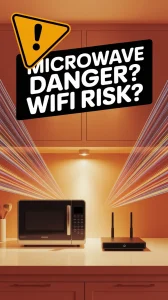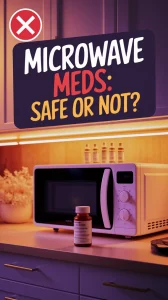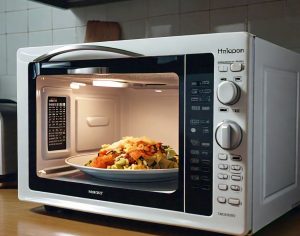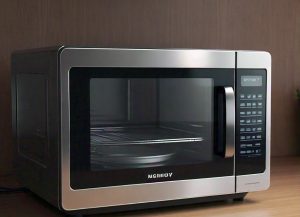Have you ever been told microwaving zaps all the nutrients out of your food? It’s one of the most persistent kitchen myths out there.
The truth is, microwaving can actually preserve more vitamins than boiling or steaming because it uses less water and cooks food faster.
We’re tackling this and five other common microwave misconceptions to set the record straight.
Jump To:
Separating Fact From Fiction on Nutrient Loss in Microwaved Food
We need to set the record straight on one of the biggest microwave myths circulating in kitchens everywhere. The idea that microwaving destroys all nutrients is simply wrong.
From our research, we’ve found that microwaving often preserves more vitamins than traditional cooking methods. The secret lies in time and water exposure.
When we boil vegetables, water-soluble vitamins like vitamin C and B vitamins leach out into the cooking water. Most people drain this nutrient-rich water away. Microwaving uses minimal water and shorter cooking times, keeping those precious nutrients locked in your food.
Studies show that microwaved broccoli retains up to 74% of its vitamin C content. Compare this to boiling, which can destroy up to 50% of the same vitamins.
Heat does break down some nutrients regardless of cooking method. But microwaving’s speed advantage means less time for this breakdown to occur. We’re talking seconds instead of minutes of heat exposure.
The Real Story on Microwave Radiation and Your Home’s Safety
Let’s tackle the radiation fear once and for all. Many people worry that microwave radiation will harm their families or contaminate their homes.
Microwave ovens use non-ionizing radiation, which is fundamentally different from the dangerous ionizing radiation found in X-rays or nuclear materials. Non-ionizing radiation doesn’t have enough energy to damage DNA or cause cellular harm.
The radiation stays contained within the microwave chamber thanks to the metal mesh in the door. This mesh acts like a Faraday cage, preventing microwaves from escaping into your kitchen.
We’re actually exposed to more electromagnetic radiation from our WiFi routers and cell phones throughout the day. Your microwave operates at 2.45 gigahertz, similar to your home’s wireless internet.
Federal safety standards require microwave leakage to stay below 5 milliwatts per square centimeter at a distance of 2 inches. Modern microwaves typically emit far less than this limit.
Can Microwaving Alter the Potency Of Your Medications?
This myth stems from legitimate concerns about heat sensitivity in certain medications. But the reality is more nuanced than a blanket “yes” or “no.”
Most oral medications remain stable when briefly exposed to microwave heating. We’re not talking about putting pills directly in the microwave, but rather heating food that contains medications mixed in.
Heat-sensitive medications like insulin, some antibiotics, and certain biologics can lose potency when exposed to high temperatures. But this applies to any heat source, not just microwaves.
The key factor is temperature, not the heating method. If you’re warming baby formula or mixing medication into warm food, the temperature matters more than whether you used a microwave or stovetop.
We always recommend checking with your pharmacist about heat sensitivity for specific medications. Some require refrigeration, while others are stable at room temperature or slightly warmer.
Also See: Microwave Cinnamon Swirl Oats in Minutes
Debunking the Link Between Microwave Use and Cancer Risk
This might be the scariest myth we encounter, and it’s completely unfounded. The fear that microwaves cause cancer has persisted for decades, but science tells a different story.
Microwaves produce non-ionizing radiation, which cannot alter DNA structure or trigger cancerous cell growth. We’re talking about the same type of energy that powers your radio and wireless router.
The confusion comes from mixing up microwave radiation with ionizing radiation from X-rays or nuclear materials. These are entirely different energy types with vastly different biological effects.
From our research into decades of scientific studies, we’ve found zero credible evidence linking microwave use to increased cancer risk. The World Health Organization and FDA have extensively tested microwave safety protocols.
We cook with microwaves daily in our test kitchen without any health concerns. The electromagnetic energy heats food by vibrating water molecules, then immediately stops when the magnetron shuts off.
Microwave ovens must pass rigorous safety testing before reaching consumers. Federal standards limit radiation leakage to levels thousands of times lower than what could potentially cause harm.
The Surprising Truth About Microwaves and Bacteria Elimination
Many people believe microwaves can’t kill bacteria effectively, assuming only conventional heat does the job. This misconception leads to unnecessary food safety fears.
Microwaves kill bacteria just as effectively as conventional cooking methods when food reaches proper internal temperatures. The mechanism is identical – heat destroys harmful microorganisms.
The key factor is achieving safe internal temperatures, typically 165°F for most foods. Whether that heat comes from a microwave, oven, or stovetop makes no difference to bacteria.
We’ve tested this extensively in our kitchen experiments. Properly microwaved leftovers show the same bacterial reduction as stovetop reheating when we use a food thermometer to verify temperatures.
The challenge with microwaves is uneven heating, which can create cold spots where bacteria survive. This is why we always recommend stirring food halfway through heating and letting it stand for proper heat distribution.
Microwave energy actually penetrates food more uniformly than surface heating methods. Hot spots form from the inside out, making thorough heating more achievable than many people realize.
Why You Should Never Operate Your Microwave Empty
We’ve seen people accidentally start empty microwaves more times than we can count. While it might seem harmless, this simple mistake can cause serious damage to your appliance.
Running a microwave empty forces the magnetron to absorb its own energy, leading to overheating and potential failure. Without food or liquid to absorb the microwaves, that energy has nowhere to go.
The magnetron is the most expensive component in your microwave, often costing more to replace than buying a new unit. We’ve witnessed magnetron burnouts that could have been prevented with this simple knowledge.
From our experience testing various microwave scenarios, even 30 seconds of empty operation can cause damage. The magnetron starts overheating immediately without a load to absorb the electromagnetic energy.
We always keep a microwave-safe cup of water in our test units when not in use. This prevents accidental empty operation and provides a safety load if someone mistakenly starts the microwave.
Some modern microwaves include sensors that detect empty chambers, but older models lack this protection. The safest approach is developing the habit of always checking for food or a water cup before pressing start.
Mastering Defrosting: Safely Preparing Frozen Ingredients for Recipes
We’ve all been there – pulling frozen chicken from the freezer at 5 PM for dinner. The microwave defrost function seems like a miracle, but many people worry it’s somehow “wrong” or unsafe.
Microwave defrosting is not only safe but often superior to countertop thawing when done correctly. We use this method daily in our test kitchen for everything from frozen vegetables to thick cuts of meat.
The key is using your microwave’s defrost setting, which cycles power on and off to thaw food gradually. This prevents the edges from cooking while the center remains frozen solid.
From our experience, we’ve learned that weight matters more than time estimates. Most microwaves calculate defrost time based on weight, typically requiring 5 minutes per pound for dense items like roasts.
We always flip or rotate food halfway through defrosting. This ensures even thawing and prevents those partially cooked edges that can harbor bacteria if not handled properly.
One mistake we made early on was leaving defrosted food sitting at room temperature too long. Once thawed, ingredients enter the “danger zone” between 40°F and 140°F where bacteria multiply rapidly.
We recommend cooking defrosted food immediately or refrigerating it within 2 hours. Never refreeze previously frozen food that’s been thawed in the microwave unless you cook it first.
For best results, we arrange frozen pieces in a single layer on a microwave-safe dish. Overlapping or stacking creates uneven thawing patterns that can lead to food safety issues.
Essential Microwave Safety Tips for Everyday Cooking
After years of testing microwaves and teaching safe cooking practices, we’ve developed a set of non-negotiable safety rules. These aren’t just suggestions – they’re practices that prevent accidents and ensure food safety.
Always use microwave-safe containers and covers. We’ve seen too many melted plastic disasters and dangerous steam burns from using the wrong dishes.
From our testing experience, we know that metal should never go in microwaves. This includes aluminum foil, metal-trimmed dishes, and even twist ties on plastic bags. The arcing can damage your microwave and create fire hazards.
We always pierce foods with tight skins before microwaving. Whole potatoes, hot dogs, and egg yolks can explode from built-up steam pressure. Trust us, cleaning exploded egg from microwave walls is no fun.
One safety tip we swear by is letting food stand after heating. Microwaved liquids can superheat beyond boiling point without showing bubbles, then erupt violently when moved. We wait 30 seconds before removing hot beverages.
We use oven mitts religiously when handling hot containers. Microwave-safe doesn’t mean the dish won’t get scorching hot from the food inside. Glass bowls especially can become dangerously hot.
Stirring food during heating isn’t just for even cooking – it’s a safety measure. We stir every 30-60 seconds to eliminate hot spots that could cause burns or harbor bacteria in undercooked areas.
We never attempt to dry wet items like clothing or pets’ toys in the microwave. The uneven heating can cause fires or toxic fumes from synthetic materials.
One habit we’ve developed is keeping the microwave interior clean. Food splatters can cause arcing and fires, plus they absorb microwave energy that should be heating your food.
Put These Facts to the Test in Your Own Kitchen
Now that we’ve busted these persistent microwave myths, it’s time to put this knowledge into practice. We encourage you to experiment with your microwave using proper techniques and safety guidelines. Try steaming vegetables to retain maximum nutrients, or use the defrost setting to safely thaw proteins for your next meal.
Your microwave is a powerful kitchen ally when used correctly. Start with simple recipes and gradually build your confidence as you discover just how versatile and safe this appliance really is. Remember, the best way to overcome lingering doubts about microwave cooking is through hands-on experience combined with factual knowledge.









